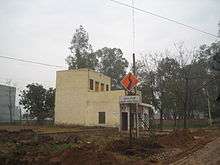Pradhan Mantri Gram Sadak Yojana
The Pradhan Mantri Gram Sadak Yojana (PMGSY) (IAST: Pradhān Mantrī Grām Saḍak Yōjanā) (Hindi: प्रधानमंत्री ग्राम सड़क योजना ) is a nationwide plan in India to provide good all-weather road connectivity to unconnected villages.[1] Of 178,000 (1.7 lakh) habitations with a population of above 500 in the plains and above 250 in the hilly areas planned to be connected by all-weather roads, 82% were already connected by December 2017 and work-in-progress on the remaining 47,000 habitations was on-track for completion by March 2019 (c. December 2017).[2]
| Pradhan Mantri Gram Sadak Yojana (PMGSY) | |
|---|---|
 Pradhan Mantri Gram Sadak Yojana marker in a village in Punjab | |
| Launched | 25 December 2000 |
| Status | Active |
| Website | pmgsy |
This Centrally Sponsored Scheme[3] was introduced in 2000 by the then-prime minister of India Late Shri Atal Bihari Vajpayee.[4] The Assam Tribune has reported that the scheme has started to change the lifestyle of many villagers as it has resulted in new roads and upgrade of certain inter-village routes in Manipur.[5]
History
The PMGSY is under the authority of the Ministry of Rural Development and was begun on 25 December 2000.[6] It is fully funded by the central government. During November 2015, following the recommendations of the 14th Finance Commission, the Sub-Group of Chief Ministers on Rationalization of Centrally Sponsored Schemes, it was announced that the project will be funded by both the central government (60%) and states (40%). In the 2000 government was announced.[7]
Aim
The aim was to provide roads to all villages
- with a population of 1000 persons and above by 2003
- with a population of 500 persons and above by 2007
- in hill states, tribal and desert area villages with a population of 500 persons and above by 2003
- in hill states, tribal and desert area villages with a population of 250 persons and above by 2007.[8]
OMMAS
In order to implement this, an Online Management , Monitoring and Accounting System or OMMAS GIS system was developed to identify targets and monitor progress.[9] It is developed by e-governance department of C-DAC pune and is one of the biggest databases in India. The system manages and monitors all the phases of road development right from its proposal mode to road completion. The OMMAS also has separate module to track the expenses made on each road. Based on the data entered by state and district officers, OMMS generates detailed reports which are viewable in citizens section (http://omms.nic.in). OMMAS incorporates advanced features like E-payment, Password protected PDF files, Interactive Reports etc.[10]
Progress
Of 178,000 (1.7 lakh) habitations with a population of above 500 in the plains and above 250 in the hilly areas planned to be connected by all-weather roads, 55% (97,838) were connected by March 2014, 82% (80% or 131,000 or 1.3 lakh under the PMGSY and 2% or 14,620 under state govt schemes) were connected by December 2017. Of the remaining 47,000, work on all is in progress except for 1700 which will be approved by the end of December 2017 and 100% connectivity will be achieved by March 2019 (16 December 2017 update).[2] Pending work included harsh terrain states of Assam, Jammu and Kashmir and Uttarakhand as well as left-wing Naxalite–Maoist extremism infested state of Chhattisgarh, some districts of Jharkhand and Malkangiri district of Odisha.[2]
The average speed of road construction under the PMGSY was 98.5 kilometers per day from 2004 to 2014, it rose to 130 km per day in by2016-17.[2]
Impact
Scheme has started to change the lifestyle of many villagers with new roads and upgrades, such as in Manipur.[5]
Complementary state schemes
Mukhya Mantri Gram Sadak Yojana run by various state governments are the schemes that complement PMGSY, including in Bihar, Chhattisgarh, Gujarat, Haryana, Madhya Pradesh, Maharashtra,[11] etc.
Green Cover
The Pradhan Mantri Gram Sadak Yojana (PMGSY) program has been attempting to increase the green cover near the roads. This is through the planting of trees saplings, including the planting of fruit bearing tree saplings. Varied levels of success has emerged from these attempts.[12][13][14][15][16][17]
References
- "PMGSY Scheme Operations Manual Chapter 1". Ministry of Rural Development, Government of India.
- 'Over 80% habitations connected with roads under PMGSY', Economic Times, 16 Dec 2017.
- "Report of the committee on restructuring of Centrally Sponsored Schemes (CSS)". Planning Commission, Government of India.
- Arvind Panagariya. "A leader of substance: Along with Narasimha Rao, Atal Bihari Vajpayee laid the foundation of new India". The Times of India, Dec 25, 2012, 12.00AM IST.
- "PMGSY roads changing lifestyle in Manipur". The Assam Tribune.
- "PMGSY Schemes & Guidelines". pmgsy.nic.in.
- "Government brings forward the target date for full completion of rural road connectivity under PMGSY by 3 years". pib.nic.in.
- "PMGSY Scheme and Guidelines: Programme Objectives". Ministry of Rural Development, Government of India, No. P-12025/8/2001-RC.
- CRISP Group, National Informatics Centre (2004) "Rural Informatics in India – An Approach Paper" from Web Archives
- Jina, Afra (3 November 2018). "UP Agriculture - Need for Transparent Agricultural Scheme". Get news on PM's schemes, central and state government schemes, central ministries and government departments. Retrieved 8 November 2018.
- Maharashtra government plans launch of Mukhya Mantri Gram Sadak Yojana, The Economic Times, 15 October 2015
- http://pmgsy.nic.in/circulars/ver_tree_plnt.pdf
- http://www.hprural.nic.in/cir273.pdf
- https://rural.nic.in/sites/default/files/PMGSY_PPT_CRM_Orientation.pdf
- https://cag.gov.in/sites/default/files/audit_report_files/Chapter_7_Joint_Physical_Verification.pdf
- http://pmgsy.nic.in/circulars/annx_200606.doc
- http://www.hprural.nic.in/cir309.pdf